11 Native Plants That Will Make Your Durham, NC, Yard Pop
BY JUDITH GALLOVA | APRIL 11TH, 2023 | DURHAM, LAWN CARE, NORTH CAROLINAYou can admire Durham’s captivating native plants in local forests and parks, but why not also grow them in your own yard? Not only will they be a beautiful addition to your property, but they’re good for the environment and easier to care for than non-natives.
Read on to find out more about native plants that work well in your Durham yard.
In this article:
- Why Use Native Plants?
- 11 Native Plants for Your Durham Yard
- How to Choose the Best Natives
- Where to Find Native Plants in Durham
Why Use Native Plants?
If you don’t already have native plants growing in your garden, it’s time to make the switch. Native plants are adapted to your local climate and soil, and they’re beneficial in numerous ways. For example:
- They’re easier to maintain.
- They’re resistant to local pests, diseases, and weather.
- They attract pollinators and birds.
- They don’t need as many chemical treatments.
11 Native Plants for Your Durham Yard
1. Highbush Blueberry (Vaccinium Corymbosum)
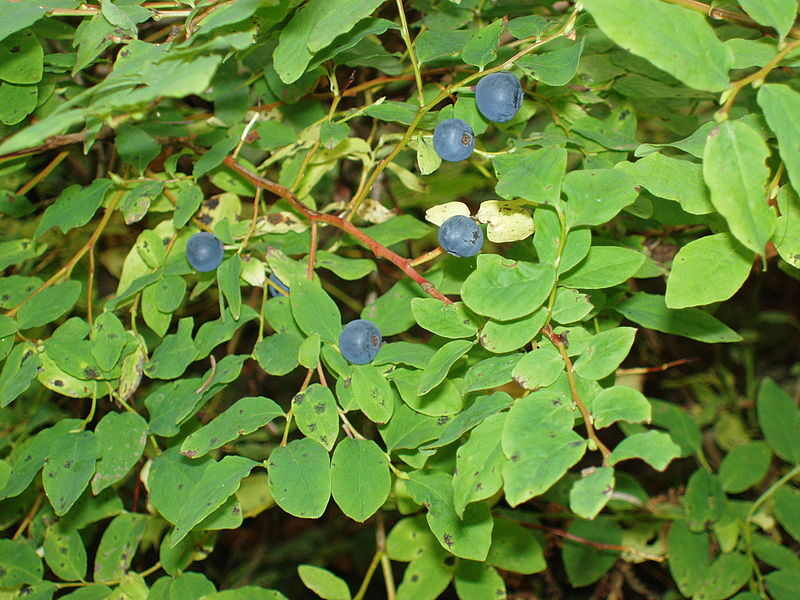
Photo Credit: Ryjial Christianson / Wikimedia Commons / CC BY-SA 3.0
As you may have guessed, the highbush blueberry isn’t just a feast for the eyes. The plant’s bell-shaped blossoms give way to delicious blueberries that are perfect for snacking. Moreover, the highbush blueberry provides food for wildlife. In fact, watch out; once your blueberries ripen, birds may like them so much that you need to cover them with netting.
Blueberries take about 6 to 8 years to fully mature, but you can plant different cultivars together to increase your berry yield. If you want optimal growth, use acidic soil and remove spent flowers regularly. Starting in the third year after planting, prune your blueberry plant as needed. Laying organic mulch is also beneficial for your highbush blueberries to grow healthy.
Plant type: Edible shrub
Hardiness zones: 3 to 8
Sun: Full sun, partial shade
Water needs: High (1 inch of water per week)
Soil: Clay, loamy, sandy; acidic, organically rich, well-drained, medium to wet
Duration: Perennial
Mature height: 3 to 12 feet
Potential hazards: None known
2. River Birch (Betula Nigra)
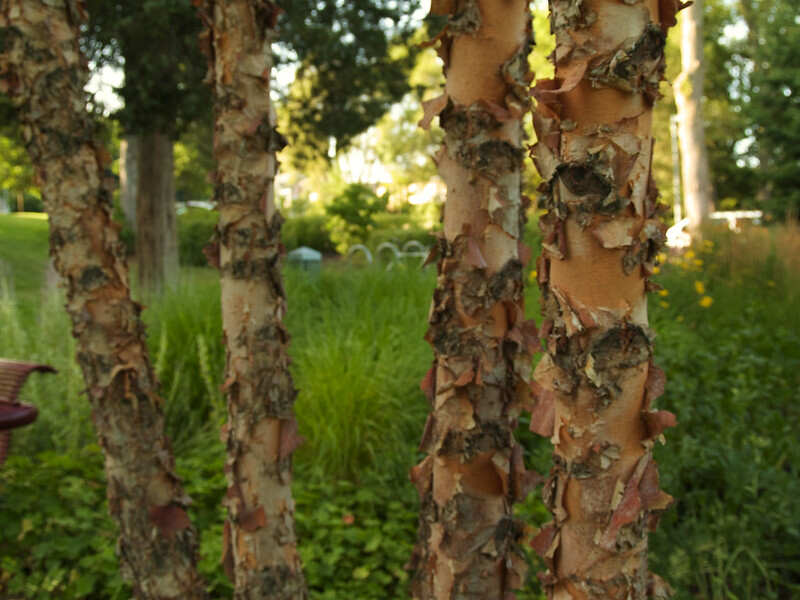
Photo Credit: RHal4D / Flickr / CC BY-SA 2.0
River birch, also called water birch, black birch, and red birch, can be a beautiful addition to your landscape the whole year round. This tree can reach 60 feet at maturity, and, because it naturally grows along riverbanks, it thrives in wet weather. However, it handles periods of drought relatively well, too.
You can help your river birch tree stay hydrated by giving it a 2- to 3-inch layer of mulch. The best time to trim the tree is in late spring or early fall. Don’t prune in spring when its sap is running.
Note that the tree has toxic effects if any part of it is consumed.
Plant type: Tree
Hardiness zones: 4 to 9
Sun: Full sun, partial shade
Water needs: Medium
Soil: Clay, loamy, sandy, average, medium to wet, moist, acidic, fertile; tolerates drier soils and poor drainage
Duration: Perennial
Mature height: 30 to 60 feet
Potential hazards: Toxic
3. Red Maple (Acer Rubrum)
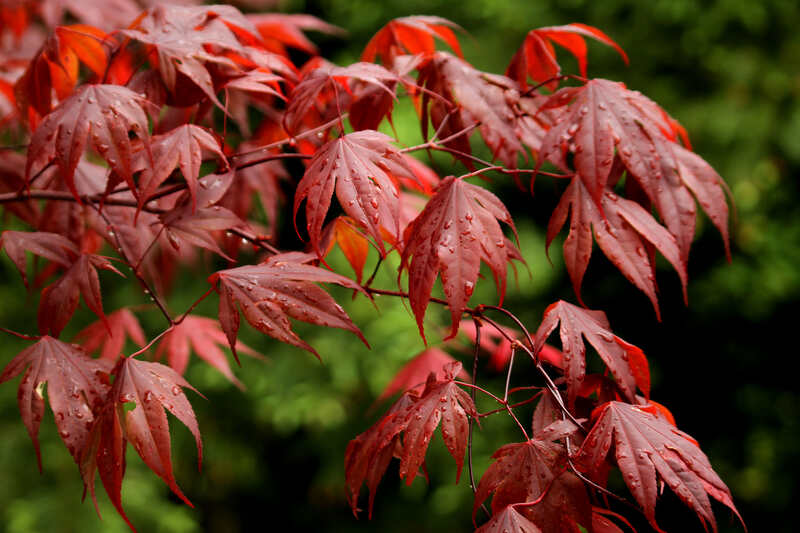
Photo Credit: Heng Wang / Wikimedia Commons / CC BY-SA 3.0
The red maple is notorious for its samaras, sometimes called “helicopter seeds.” These winged seeds spin when they fall from the tree, creating a fun and unique display. The tree is also the first to bloom in spring and change color in the fall, making it a showy addition to your yard throughout the year.
Although it will take a number of years, the tree can grow up to as high as 120 feet in full sun or partial shade. The tree tolerates many kinds of soil, but to retain moisture and keep your red maple healthy, you should lay a layer of mulch.
However, take note that the red maple is highly toxic to humans and animals, especially its leaves and bark. If you have children or pets, make sure they don’t ingest any part of the tree.
Plant type: Tree
Hardiness zones: 2 to 9
Sun: Full sun, partial shade
Water needs: Medium
Soil: Clay, loamy, sandy, average, medium to wet, well-drained; tolerant of various soils but prefers moist, slightly acidic soils
Duration: Perennial
Mature height: 40 to 120 feet
Potential hazards: Toxic
4. Coastal Azalea (Rhododendron Atlanticum)
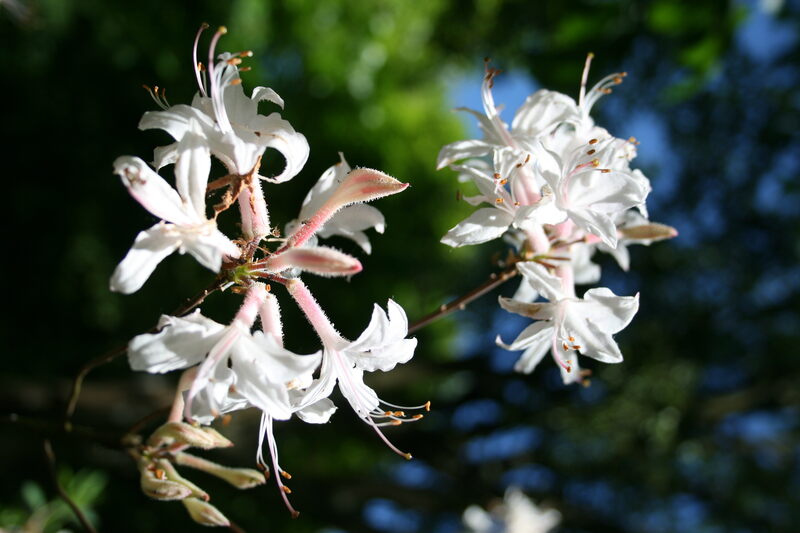
Photo Credit: Jean-Pol GRANDMONT / Wikimedia Commons / CC BY-SA 3.0
The coastal azalea forms a dense hedge, creating privacy and curb appeal. It has fragrant flowers that are a magnet for butterflies, bees, and hummingbirds. Depending on the variety and your soil type, your coastal azalea may grow up to 8 feet tall, but it usually grows up to 2 to 3 feet tall.
You should ideally provide your azalea with consistent moisture, but make sure that your soil is well-draining to avoid root rot. Because most of Durham has clay-heavy Utisol soil, it’s advisable to plant your azalea in a raised flower bed.
To keep your azalea looking its best, clip off its spent flower clusters after bloom. Mulching can help the soil retain moisture and manage its temperature. Full sun exposure can damage the plant, so make sure you provide it with the right amount of shade.
Take note: azaleas are severely toxic. Don’t eat any part of the plant, and make sure children and pets stay away from it.
Plant type: Flowering shrub
Hardiness zones: 1 to 8 (some may grow shorter, depending on variety and soil type)
Sun: Partial shade
Water needs: Medium
Soil: Light, acidic, sandy, well-drained; tolerates well-drained humusy loams
Duration: Perennial
Mature height: 2 to 6 feet
Potential hazards: Toxic
5. Lance-Leaved Coreopsis (Coreopsis Lanceolata)
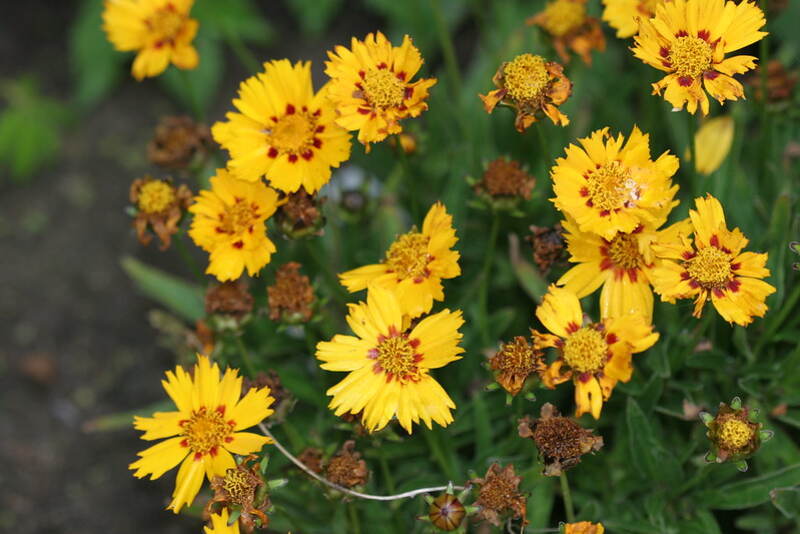
Photo Credit: Andrey Zharkikh / Flickr / CC BY 2.0
Lance-leaved coreopsis, also called tickseed, is a lovely yellow wildflower that can grow up to 2 feet even in bare areas. It doesn’t only look appealing to the human eye but also attracts pollinators and birds.
This perennial wildflower is quite durable and resists heat, drought, and humidity. Because the plant spreads so easily, make sure to contain it so that it doesn’t overtake your garden. On the other hand, if you want to encourage new blooms, you should deadhead your lance-leaved coreopsis flowers with scissors.
There are various plants in the Coreopsis species, and they’re generally seen as non-toxic. However, there isn’t a lot of data about the toxicity of lance-leaved coreopsis in particular, and there are some reports of toxicity to livestock Because the plant may have toxic effects, it’s always better to be cautious.
Plant type: Wildflower
Hardiness zones: 4 to 9
Sun: Full sun
Water needs: Medium
Soil: Loamy, sandy, dry to medium moisture, well-drained; ideally poor, sandy or rocky soils
Duration: Perennial
Mature height: 1 to 3 feet
Potential hazards: Some reports of toxicity
6. American Beautyberry (Callicarpa Americana)
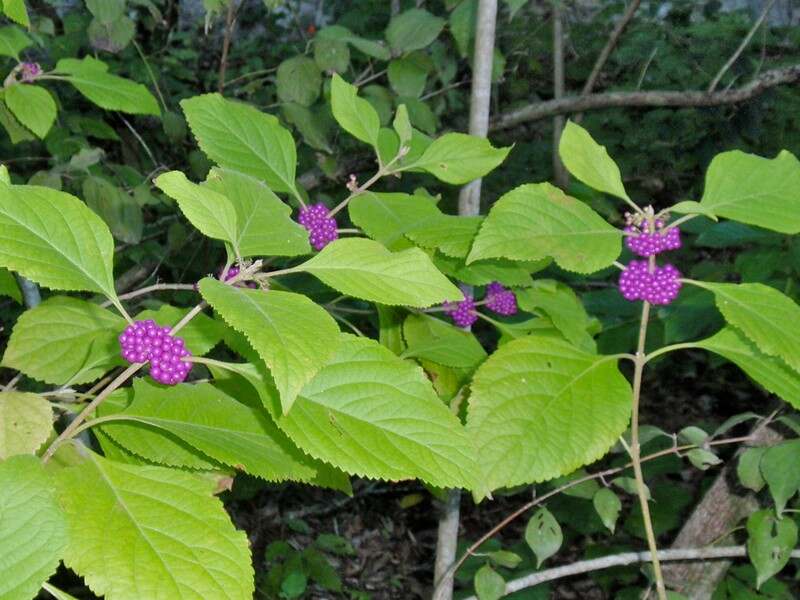
Photo Credit: John Pavelka / Flickr / CC BY 2.0
Are you looking to add a pop of color to your yard? Consider planting the American beautyberry, which produces clusters of bright purple berries in the fall. The berries are not only beautiful but also a valuable food source for birds during the winter months. Moreover, the American beautyberry can even act as a natural mosquito repellant.
If you’re looking for a low-maintenance option, you’ll be glad to find out that this shrub is relatively easy to care for. The American beautyberry doesn’t have any big problems with pests, and it can also handle some drought, though too much of it could be a problem.
You may need to prune your American beautyberry in winter if you want to encourage more growth. Also, make sure to remove dead wood in spring. The plant thrives in full sun but can tolerate light shade.
American beautyberry is listed as non-toxic to humans on calpoison.org. Its berries can even be made into jelly. However, some sources report that they may have mildly toxic effects. To find out more information, you can discuss any dietary changes with a medical professional. Because there’s a lack of data about the plant’s toxicity to domestic animals, you should keep them from eating it.
Plant type: Shrub
Hardiness zones: 6 to 10
Sun: Full sun
Water needs: Low
Soil: Clay, loamy, sandy, moist, well-draining, rich in organic matter; tolerant of various soil types as long as it gets good drainage
Duration: Perennial
Mature height: 3 to 8 feet
Potential hazards: Mild toxic effects reported; a lack of data regarding toxicity to pets
7. Winterberry Holly (Ilex Verticillata)
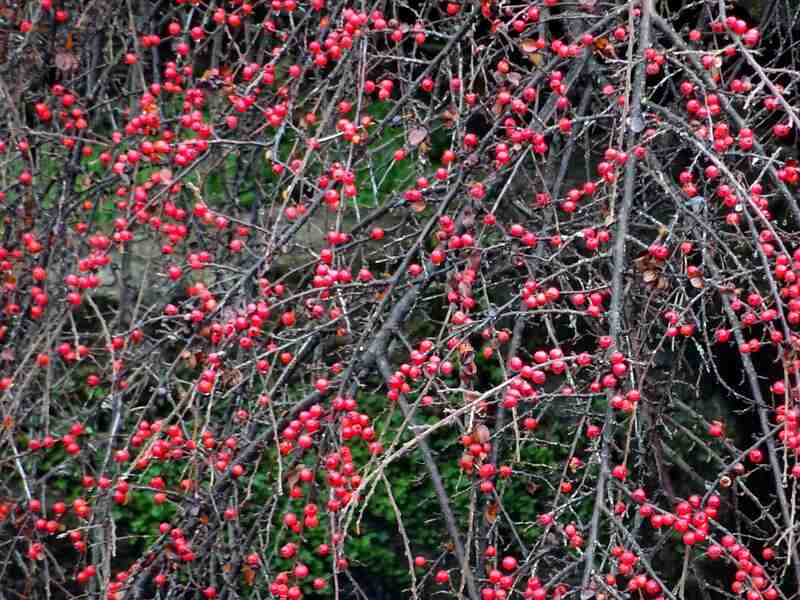
Photo Credit: PublicDomainPictures
If you want to add a bit of color to your lawn through the winter, the winterberry holly, also known as the black alder, is a fitting choice. The plant features red berries throughout the winter and also provides food and shelter for birds and pollinators in the summer.
While it can grow in the shade, this shrub also tolerates heat and drought. It handles wet, swampy, or boggy conditions and both light and heavy soils. Its preference is, however, for moist, organic, acidic soils. Moreover, the winterberry holly is susceptible to some plant diseases, so make sure that you address any signs of infection promptly.
Take note that although the plant provides food for wildlife, it’s toxic to humans, domestic animals, and livestock, including dogs, cats, and horses.
Plant type: Tree or large shrub
Hardiness zones: 3 to 9
Sun: Full sun, partial shade, deep shade
Water needs: Moderate
Soil: Clay, loamy, sandy, average, medium to wet soils; ideally moist, organic and acidic soils
Duration: Perennial
Mature height: 3 to 15 feet
Potential hazards: Toxic
8. Heart-Leaved Aster (Symphyotrichum Cordifolium)
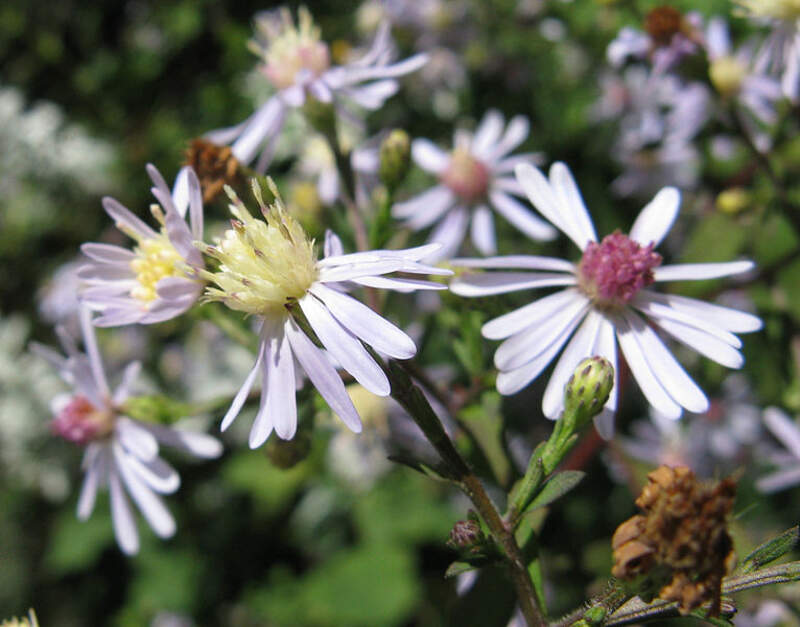
Photo Credit: Nadiatalent / Wikimedia Commons / CC BY-SA 3.0
The heart-leaved aster is also called the heart-leaved American aster and blue wood aster. It produces delicate blue-purple wildflowers that attract butterflies and bees.
If you’re looking for an easy-care plant, the heart-leaved aster is a great option. It’s resilient and low-maintenance, and can thrive in partial shade. Provide it with good air circulation to avoid diseases.
If you don’t deadhead your heart-leaved aster, it’s likely to self-seed. Moreover, you should pinch back stems a number of times before mid-July if you want to control the plant’s look and height. If you do this, you may not need to stake the plant.
Little is known about the hazards of the heart-leaved aster. However, the aster species includes many different types of plants, some of which are severely toxic, so practice caution.
Plant type: Herb
Hardiness zones: 3 to 8
Sun: Full sun, partial shade
Water needs: Low
Soil: Loamy, sandy, average, well-drained; ideally rich and dry to moist (not too moist)
Duration: Perennial
Mature height: Typically 2 to 5 feet; occasionally can grow to 6 feet
Potential hazards: None known due to a lack of data; other plants of the species are highly toxic, so practice caution
9. Switchgrass (Panicum Virgatum)
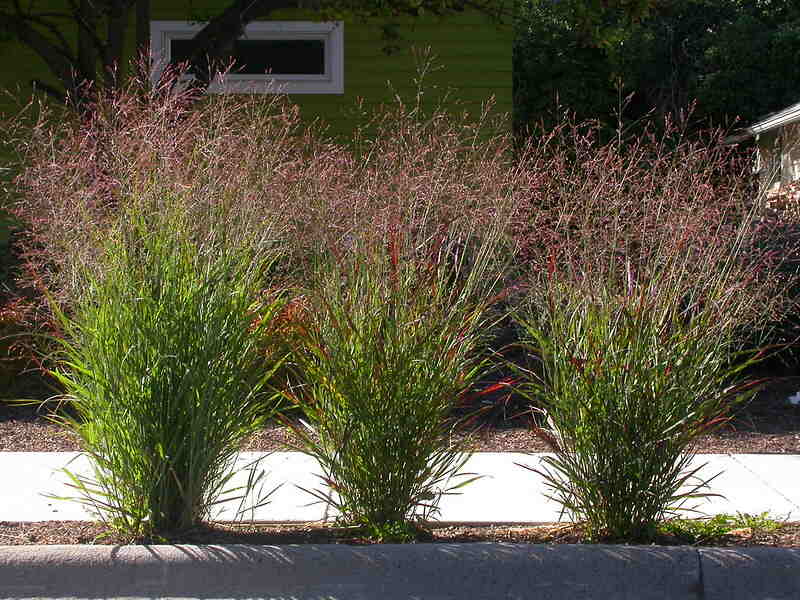
Photo Credit: Matt Lavin / Flickr / CC BY-SA 2.0
If you want to add a dash of vibrance to your landscape, you can consider switchgrass. Not only can it grow quite tall, but it stands out with its colorful foliage.
The first shoots of this tall grass emerge in the summer and brighten up the space with a burst of green. As fall approaches, it turns red and purple. Finally, switchgrass stays yellow throughout the winter.
While this ornamental grass prefers moist, clay, or sandy soils, it can grow in a variety of soils. Overly rich soils may cause the grass to flop. You should cut your switchgrass clumps back between late winter and early spring.
Switchgrass is also a source of food for pollinators and birds. However, it’s toxic to some animals, so be cautious with your pets.
Plant type: Ornamental grass
Hardiness zones: 5 to 9
Sun: Full sun, partial shade
Water needs: Medium
Soil: Clay, loamy, sandy, average, medium to wet; prefers moist clay or sandy soil; can tolerate periods of drought and flooding
Duration: Perennial
Mature height: 3 to 6 feet
Potential hazards: Toxic to some animals
10. Butterfly Weed (Asclepias Tuberosa)
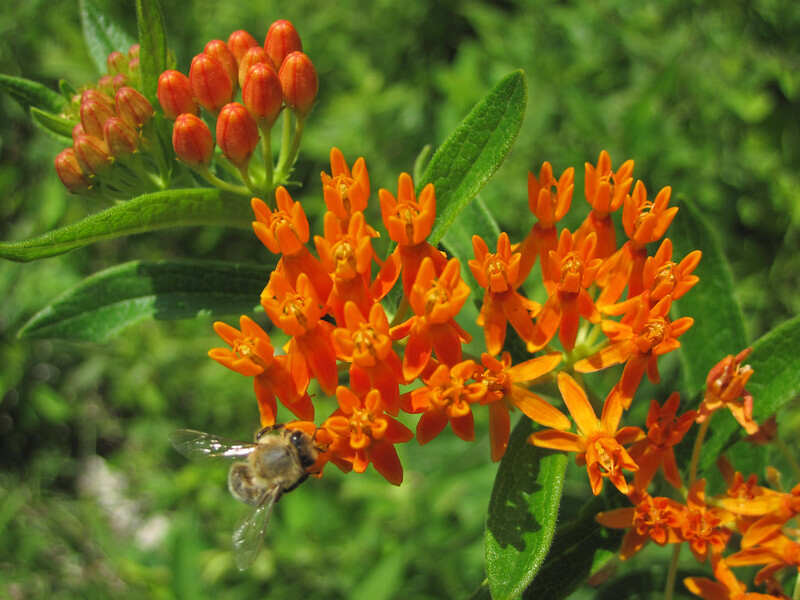
Photo Credit: James St. John / Flickr / CC BY 2.0
Butterfly weed is also known as orange milkweed. The milkweed family is the only host plant for monarch caterpillars as well as a delicious food source for adult butterflies. Apart from butterflies, hummingbirds also like to snack on butterfly weed’s nectar.
Apart from being an important natural food for wildlife, butterfly weed can also look amazing on your lawn. It may take up to 2 or 3 years to establish, but after that, you’ll get a yearly display of bright orange flowers.
When it comes to caring for your butterfly weed, think about the right spot to plant it. It should stay in its place once established and not be transplanted because of its deep taproot. To thrive, it should grow in full sun. It’s drought tolerant, so warm summer weather shouldn’t pose a problem. If you don’t want your butterfly weed to self-seed, remove seed pods before they split open.
Take caution; butterfly weed is a toxic plant.
Plant type: Herb
Hardiness zones: 4 to 10
Sun: Full sun
Water needs: Low
Soil: Sandy, poor, average, dry to medium, well-drained
Duration: Perennial
Mature height: 1 to 2 feet
Potential hazards: Toxic
11. Green and Gold (Chrysogonum Virginianum)
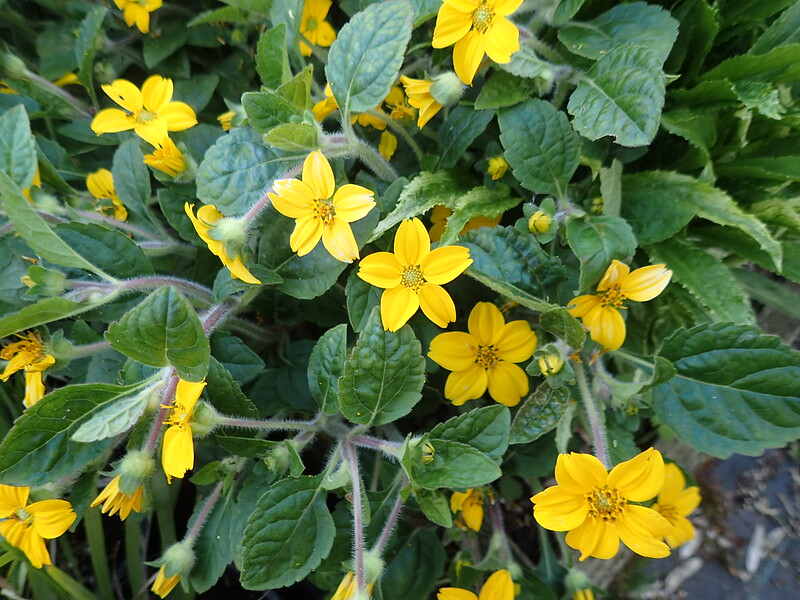
Photo Credit: peganum / Flickr / CC BY-SA 2.0
Green and gold has delicate, golden-yellow flowers that bloom in the spring and summer. Don’t let its outward appearance fool you, though. This evergreen ground cover is resilient and can withstand weeds and diseases. Moreover, it also attracts songbirds and pollinators, including bees and butterflies.
This ground cover is also perfect for filling in gaps between other plants in your garden because it grows in shady areas. If your turfgrass can’t handle the shade, green and gold is a great option to make your lawn look complete and lush. Just watch out for mildew and contain the plant by removing spent flower stems.
Green and gold has no known toxic effects, but it isn’t confirmed to be non-toxic either, so always proceed with caution.
Plant type: Ground cover
Hardiness zones: 5 to 9
Sun: Partial shade, deep shade; tolerates full sun only if it grows in consistently moist soils
Water needs: Medium
Soil: Loamy, medium moisture, average, well-drained; ideally moist, acidic, rich with organic matter
Duration: Perennial
Mature height: 1 to 2 inches
Potential hazards: None known (lack of data)
How to Choose the Best Durham Natives for Your Landscape
Each Durham native has its own unique characteristics. Make sure you consider the unique traits of the plant, such as soil needs, shade needs, and potential hazards, before you pick the plants for your landscape.
Also, take note that just because a plant doesn’t have known hazards doesn’t mean it’s completely safe, so be careful and keep an eye on children and pets around all plants. If you want to know about the medicinal or edible uses of any plant, consult a medical professional.
One more important thing to consider is your area’s hardiness zone. Durham’s hardiness zone is 7b, which means its minimum temperatures are between 5 and 10 degrees Fahrenheit. Any plants you get need to match this hardiness zone to handle Durham’s coldest weather conditions. But there’s no cause for concern; all the plants in this article are a good fit for Durham’s climate.
Where to Find Native Plants in Durham
Durham has a number of stunning native plants. But if you spot any of them in nature, don’t bring them home. Moving plants out of their natural habitat can disrupt the ecosystem and harm wildlife. Instead, get your plants ethically from local nurseries.
Examples of Durham nurseries are:
Final Thoughts
Once you pick your natives, you’re one step closer to establishing a beautiful landscape, but you’re not done just yet. Don’t forget to also pick the right grass type. and consider all the maintenance work you’ll need to do throughout the year.
If you want to provide your landscape with the right care, consider hiring one of WikiLawn’s local pros who can handle it for you.
Main Image Credit: Red maple / David J. Stang / Wikimedia Commons / CC BY-SA 4.0